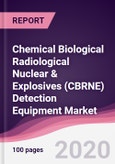The Chemical Biological Radiological Nuclear & Explosives (CBRNE) Detection Equipment market is classified on the basis of detection, portability type, system, end user, and geographical regions. Due to increased security, safety and law enforcements within public and private places, people are becoming more secure and conscious about critical situations and incidents. This has led to a reduction in terrorism and, in turn, boosted the growth of the CBRNE detection equipment market. The CBRNE Detection Equipment Market is estimated to grow at a CAGR of 4.89% during the forecast period 2019–2025. The Middle East and Africa regions are forecast to be the fastest growing markets during the forecast period 2019–2025. The regions are estimated to grow at a combined CAGR of 6.73%, which can be mainly attributed to the domestic disturbances in these regions over the past few years. The increase in concern to protect civilian lives, which includes preventive measure to safeguard them from hazardous items and threats from terrorist organizations, is compelling state governments to invest in CBRN detection equipment.
CBRNE Detection Equipment Market Outlook
CBRNE Detection Equipment has the capability to detect CBRNE materials. This equipment has high specifications and features, such as high range detection system with high frequency catcher, which comes under area monitoring. CBRNE detection equipment have a wide range of as applications in defense, academic and research, commercial and logistics security, food and agriculture, environmental, quality control, and various other sectors.
Food and Agriculture has the highest growth rate in terms of usage of CBRNE detection equipment among the end users. The CBRNE detection equipment in food and agriculture is forecast to grow at a CAGR of 6.32% during the forecast period 2018–2023 and reach $317.91m by 2023.
CBRNE Detection Equipment Market Growth Drivers
Chemical detection equipment has the potential to detect chemical reagents in the environment. The increase in threat from chemical warfare agents, industrial pollutants in water bodies, and toxic leakage or accidents in industries are driving the demand for chemical detectors. Chemical detectors are also used for drug identification in the pharmaceutical industry and for narcotics monitoring. They act as pre-alarming systems to minimize the loss of lives and trigger the safety measures.
CBRNE Detection Equipment Market Challenges
Biological detection systems should have high sensitivity to detect very small amounts of biological agents, and should be able to distinguish biological agents. Training the user to use CBRNE detection equipment is one of the challenges in the CBRNE equipment market. The purpose of the first responders or military is to detect the threat and protect using these CBRNE equipment. Proper training has to be given to the end users by the manufacturers or distributors
CBRNE Detection Equipment Market Research Scope
The base year of the study is 2017, with forecast done up to 2023. The study presents a thorough analysis of the competitive landscape, taking into account the market shares of the leading companies. These provide the key market participants with the necessary business intelligence and help them understand the future of the CBRNE Detection Equipment market. The assessment includes the forecast, an overview of the competitive structure, the market shares of the competitors, as well as the market trends, market demands, market drivers, market challenges, and product analysis. The market drivers and restraints have been assessed to fathom their impact over the forecast period. This report further identifies the key opportunities for growth while also detailing the key challenges and possible threats. The key areas of focus include the types of detection systems in the CBRNE detection equipment market, and their specific applications in different industries.
CBRNE Detection Equipment Market Report: Industry Coverage
CBRNE Detection Equipment Market – By Type of Detection: Chemical Detection, Biological Detection, Radiological and Radiation Detection, Nuclear Detection, and Explosive Detection
CBRNE Detection Equipment Market – By System: Spectrometers, Radiation Detectors, Reconnaissance Vehicles, Unmanned Vehicles, Training Simulators, and Others
CBRNE Detection Equipment Market – By End User: Military and Forces, Commercial and Logistics Security, Food and Agriculture, Environmental Health, Pharma/Biopharma, Microbiology, and Others
CBRNE Detection Equipment Market – By Portability: Handheld and Man Portable Detection Equipment, and Installed Detection Equipment
The CBRNE Detection Equipment market report also analyzes the major geographic regions for the market as well as the major countries for the market in these regions. The regions and countries covered in the study include:
North America (U.S., Canada and Mexico)
South America (Brazil, Venezuela, Argentina, Ecuador, Peru and Rest of South America)
Europe (U.K, Germany, France, Italy, Netherlands, Belgium, and Rest of Europe)
APAC (China, India, Japan, South Korea, and Rest of APAC)
Rest of the World ( Middle East and Africa)
CBRNE Detection Equipment Market Key Players Perspective
Thermo Fisher Scientific Incorporation and Smiths Group Plc are the two major providers of CBRNE detection equipment globally. They together accounted for approximately 39.45% share of the overall CBRNE detection equipment market in 2017.
Battelle Memorial Institute and , on the other hand, accounted for 13.21% of the overall revenue in 2017, while Bruker Corporation and FLIR Systems Incorporation accounted for 4.88% and 4.67% respectively. Kromek Group had a very small share in the CBRNE detection equipment market in 2017.
CBRNE Detection Equipment Market Trends
Radiological detection equipment are widely used for diagnosis for X-rays and cardiovascular imaging in the medical industry, and for security check-ins at airports, railways, and other public places.
CBRNE equipment has high sensitivity to detect very small amounts of biological agents and has the capability to distinguish between biological agents and other hazardous substances. It requires highly trained and efficient handlers to handle this equipment.
The usage of CBRNE detection equipment at the global level is expanding rapidly with growing threats from terrorist organizations, hostile environment, and civil unrest in various countries.
Table of Contents
Methodology

LOADING...








